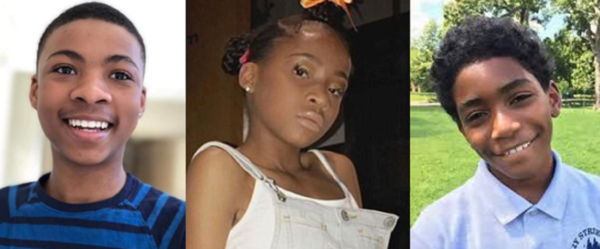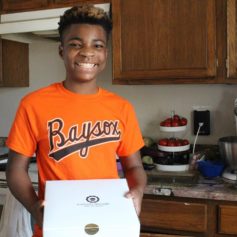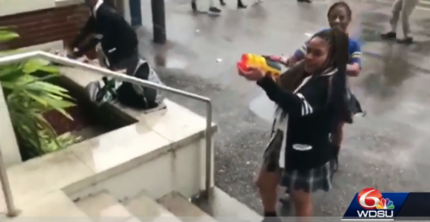
Black children in America are having a hard time of it, as studies point to an increase in suicides. In a community where suicide is not viewed as a “Black thing,” and discussions about mental health are often viewed as taboo or not taken seriously, the statistics suggest that more must be done to stem the tide of a growing epidemic.
With historical adversity, psychological distress and racism impacting their mental health, the Black community is no stranger to suicide in America. Africans committed suicide on slave ships — in the case of the 1806 Igbo Landing mass suicide, Africans took their lives as an act of resistance — and on the plantation out of their suffering in captivity.
Historically, while Black suicide rates have been lower than white rates, Black suicide rates have been growing at a higher rate than those of their white counterparts, particularly from 1965 onward. Further, in recent years suicide rates among Blacks across age groups have been lower than those for whites, Native Americans — who have the highest suicide rates — and comparable to Latinos and Asian Americans. However, research also suggests Black suicides have been more prone to misclassification and therefore likely underrepresented in the data, which would help explain the paradox of lower Black suicide rates despite the mental health risks Black people face.
Traditionally, Black youths have had a lower suicide rate than white youths, according to the Centers for Disease Control and Prevention. However, a study published by the journal JAMA Pediatrics in 2018 revealed that the suicide rate among Black children under 13 years is now double the rate for white children in that age group. This reality applies to both girls and boys, the study says, and white suicide rates surpass Black rates in the teen years.
The study came as the Centers for Disease Control and Prevention reported that suicides among black children under 18 increased 71 percent from 2006 to 2016, at a time when suicides among all children rose 64 percent. Some of the possible reasons offered for the increase include the impact of racism placing Black children at a higher risk, and the notion that suicide is not an issue in the Black community, thereby hampering any efforts at suicide prevention. In the Black community, there are false notions that people living with a mental health condition are “crazy” or just need to be stronger, and that one can simply “pray away” depression.
Other potential factors include issues such as easy access to the materials used to commit suicide, a profound feeling of loss or isolation, and bipolar disorder. Further, experts note that the racially disparate rates of children taking their own lives also reflect the general gap in health outcomes among Black people and their white counterparts. While suicides among Black children between 5 and 11 years old have increased substantially since the 1990s, researchers have not identified one particular reason to explain the disparity, and more research is necessary.
Suicide in America is now at its highest level in 50 years. The level of suicides was greater in 1933 during the Great Depression — as is the case in hard economic times — and dropped among all groups, including African-Americans, with the end of World War II.
A number of suicides of Black children, adolescents and young people have received media attention and focused attention on the issue. In 2018, Stormiyah Denson-Jackson, 12, killed herself in her dormitory at SEED Public Charter School in southeast Washington, D.C. Her family sued, accusing the school of not doing enough to prevent her death. Stormiyah, who according to family had previously attempted to take her own life, reportedly died a month after she told school psychologists she “didn’t want to live anymore.” The school allegedly concluded she was a “low-level suicide threat,” and “her grades were suffering and she was getting into trouble frequently.” Also that year, Rylan Thai Hagan, 11, hanged himself from his bunk bed with a belt. A trumpet player and model student, the sixth-grader from Washington, D.C., took his life days before Thanksgiving, and after qualifying for a basketball tournament at Walt Disney World.
Actress Taraji P. Henson, star of “Empire,” “Hidden Figures” and other TV and film projects, recently testified before a Congressional Black Caucus Emergency Taskforce on Black Youth Suicide and Mental Health. “We can’t give up on our kids,” said Henson. “The more we talk about [mental health], the more people will feel like they can talk about it.” Henson, who suffers from anxiety and depression, created the Boris Lawrence Henson Foundation — named for her late father — to address suicide, mental health and prisoner recidivism.
“The ages of the children committing suicide are getting younger and younger. It breaks my heart that 5-year-old children are contemplating life and death,” Henson said at the hearing. “In the African-American community, we don’t deal with mental health issues,” she added. “We don’t even talk about it. We’ve been demonized for coming out saying we have issues.”
Other organizations are addressing mental health and suicide in the Black community, whose members are less likely to seek care. For example, the Siwe Project, which was formed to promote mental health awareness among people of African descent and reduce the stigma of mental illness and therapy, was named for Siwe Monsanto, 15, who committed suicide. No More Martyrs is a mental health awareness campaign supporting Black women living with mental health concerns.
I Live For is a nonprofit organization which uses storytelling, including short films, live events and social media to end the stigma of mental health issues such as depression and anxiety among teens and young adults of color. The founder of the organization, Nikki Webber Allen, is an entertainment industry veteran whose nephew Paul, 22, committed suicide in 2013 after struggling with anxiety and depression.
“At the time I wasn’t aware he was struggling from depression and anxiety disorder. His family did know, and he had been in therapy and his parents did everything they could to support him. He was a churchgoing kid, very spiritual had a deep connection to God and the church,” Allen told Atlanta Black Star. She noted that her nephew was an exceptionally bright young man who had a full scholarship to Morehouse College. Allen debunked the myth that people who commit suicide are outliers, nerdy, and the like. “But that’s not the case. The majority of people who die by suicide are your loved ones, your neighbors your friends,” she added.
Lee said she was devastated by Paul’s death because of her own anxiety and depression. “It broke my heart that he didn’t feel comfortable telling me about it, and I didn’t feel comfortable telling him about it,” Lee said. “I didn’t want to let him down and feel weak. And I learned he felt the same way. He didn’t want to share it because he didn’t want to let us down. Families are not being honest about it. Families have to know they can help and support and not be ashamed.”
Responding to her nephew’s suicide, Lee decided she had to do something. “When we lost Paul, I said this cannot be in vain. We are blessed with resources. My dad’s a judge, my mom’s a schoolteacher. It’s a loving supportive family, I’ve been in the television industry for 25 years. God didn’t put me on this earth with a loving family, connections through my television and storytelling not to do anything. I’ve been too blessed not to do anything.” Without having experience in nonprofits, Lee found her calling. With Paul’s parents’ blessing, she shared his story. “I believe that sharing stories about people who look like them is the best way to tackle stigma,” Lee said, noting that she hopes to create awareness. “Stories break stigma, and I started working on a documentary film. … I did a TED talk that has been viewed over 2 million times, I get emails and direct messages from around the world who say thank you for sharing your story.”
According to Lee, while a stigma already exists around mental health issues, that stigma is even more pronounced among Black and Brown communities. “Particularly within the states, when you look at the research, we have a greater stigma around mental health, but we have a greater risk around mental health,” she noted. “When you look at socioeconomic disparities, not being able to have access to health care, you add greater risk and greater stigma, you have a powder keg. That’s why I’m so passionate about speaking out. People you don’t have to suffer in silence. Our ancestors didn’t have access to things we have access to. If they could have they should have,” she added.
“It’s critical because these things can be managed. I still live with depression and anxiety, which ebbs and flows, but it doesn’t define me,” Lee said. “Through therapy I’ve learned self-care rituals such as yoga meditation and diet. Sometimes I fall off the wagon. … We constantly have to be aware and mindful of our mental health, especially if you are prone to anxiety and other mental health disorders.”
When asked about the underlying issues driving suicide among Black children and what is needed to address it, Lee said more research is necessary to understand the causes, of which people are not yet aware. “My first thought is it is across the board. We are experiencing in this country a huge increase in suicide, alcohol abuse and drug abuse, which are interrelated. … You use it to medicate the pain,” she said. “Suicide, depression and anxiety are increasing, and social media has contributed hugely to the increase in depression, suicide and anxiety among young people.
Further, Lee identifies changing family structure and increasing family instability, and the breakdown in some of the institutional foundations that were important in the Black community. “Younger generations are moving away from the church. They are more skeptical and not attending it as much. Whether you’re religious or not, the Black church was a large part of our foundation. And I wonder if that is breaking down a bit, and if that is one of those foundational changes that is hurting the community,” Lee added, also noting that often, people mistakenly believe that people can “pray away” their mental health issues by going to church, as opposed to doing it in tandem with professional treatment.
In addition to issues of racism, Lee also identifies social media and cyberbullying as factors contributing to suicide. “The bullying is so much worse. You have access to it 24/7. And this culture — social media is like a highlight reel of people’s best lives … and it looks like people have a perfect life, and my life sucks. People are putting it on and showing their best selves. Everyone is having a good time,” she said. “Combine that with racism, disparities, everybody has more money. I really think it’s a bad combination.” Studies have shown a link between social media and anxiety in teens, and researchers believe the potential links between social media — including cyberbullying — and suicide as a public health issue.
Suicide among Black youth occurs disproportionately among boys, with males accounting for as much as 80 percent of suicides among all African-Americans, according to Dr. Sean Joe, associate dean for faculty and research at the Brown School at Washington University in St. Louis. “Anxiety is a very important predictor for suicidal behavior, particularly among Black Americans,” Joe said in a podcast from the McSilver Institute for Poverty Policy and Research at NYU. He noted that while suicide risks increase for whites as they age, for Black people the risk is highest for people under 35. Factors such as homelessness, psychiatric disorders, social isolation and trauma elevate the risk for suicide.
Further, Joe noted that Black youth are developing under different circumstances than previous generations of African-Americans, and are more accepting of the notion of taking one’s life. “If you find a Black male exhibiting signs or talking in a self-destructive way — that they don’t think life is worth living, that they feel that the world is against them — and if they are exhibiting any signs that are potentially signs of suicide and their behaviors are starting to change, they are starting to give away things and they’re trying to isolate themselves in a very concerning way, you want to take those signs very seriously and consider getting your child assessed and connect them with a therapist.”
While more work is needed to understand why Black children and young people are taking their lives, acknowledging the problem and coming to terms with Black mental health is a step in the right direction.


